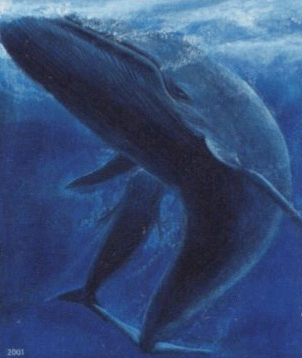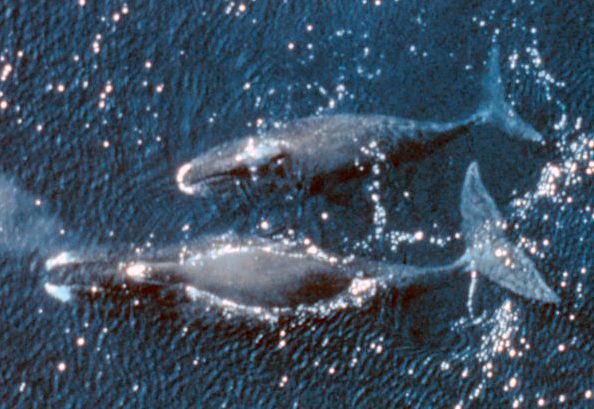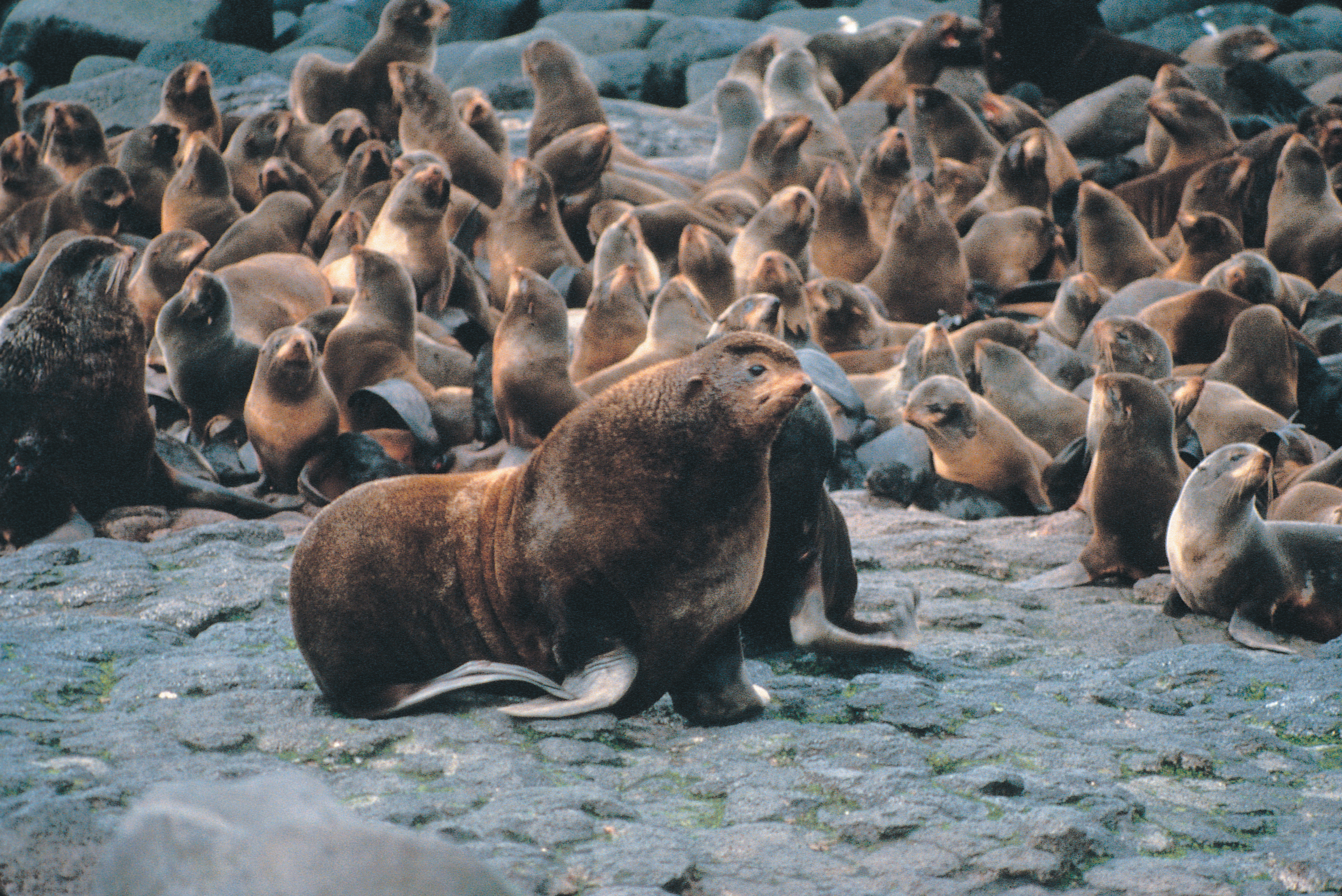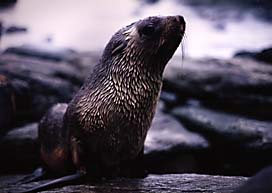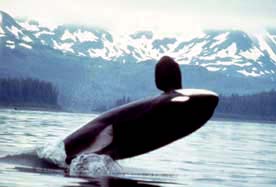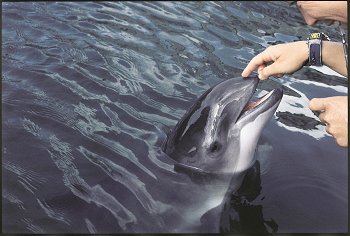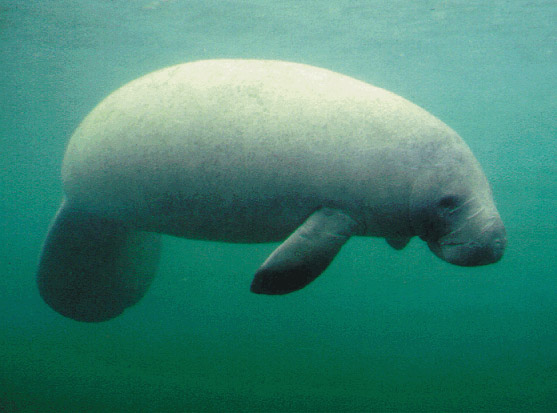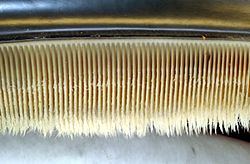AY Honors/Marine Mammals/Answer Key
1Be able to identify three of each of the following and know where each is foundKnow at least one by scientific name from each group:
aToothed Whales
Sperm whale (Physeter macrocephalus)
Where found: Sperm whales are found in all the oceans of the world.
Description: The Sperm Whale is the largest of all toothed whales and is the largest toothed animal alive, measuring up to 18 meters (60 ft) long, as well as being the largest known predator ever to exist, apart from the blue whaleThe Sperm Whale's enormous head and distinctive shape, as well as its central role in Herman Melville's Moby-Dick, have led many to describe it as the archetypal whale.
Pygmy sperm whale (Kogia breviceps)
Where found: Pymgy Sperm Whales are found in the temperature waters of the Atlantic, Pacific and Indian OceansHowever, they are rarely sighted at sea, so most data comes from stranded animals - making a precise range and migration map difficultThey are believed to prefer off-shore waters.
Description: The Pygmy Sperm Whale is one of three species of whale in the sperm whale familyThey are not often sighted at sea, and most of our understanding of the creatures comes from the study of washed-up specimens.
Monodon monoceros
Narwhal (Monodon monoceros)
Where found: The narwhal is an Arctic species of cetaceanIt is a creature rarely found south of latitude 70°N.
Description: The most conspicuous characteristic of male narwhals is their single extraordinarily long tusk that projects from the left side of the upper jaw and forms a left-handed helixThe tusk can be up to 3 m (nearly 10 ft) long (compared with a body length of 4–5 m [13–16 ft]) and weigh up to 10 kg (22 lb).About one in 500 males has two tusks, which occurs when the right tooth, normally small, also grows outAlthough rare, a female narwhal may also produce a tusk.
Beluga whale (Delphinapterus leucas)
Where found: The Beluga Whale or White Whale is an Arctic and sub-arctic species of whale.
Description: The Beluga Whale is commonly referred to simply as the Beluga - the word derives from the Russian word for white The head is also unlike that of any other cetacean - its melon is extremely bulbous and even malleableThe beluga is able to change the shape of its melon by blowing air around its sinuses
Dolphins and porpoises are also classified as toothed whales, but since they appear as a separate group in this requirement, they are not listed here.
bBaleen Whales
Blue Whale (Balaenoptera musculus)
Where found: Blue Whales were abundant in most oceans around the world until the beginning of the twentieth centuryFor the first 40 years of that century they were hunted by whalers almost to extinctionHunting of the species was outlawed by the international community in 1966A 2002 report estimated there were 5,000 to 12,000 Blue Whales worldwide located in at least five groupsBefore whaling the largest population was in the Antarctic but now there remain only much smaller (around 2,000) concentrations in each of the North-East Pacific, the Antarctic, and the Indian OceanThere are two more groups in the North Atlantic and at least two in the Southern Hemisphere.
Description: The Blue Whale is believed to be the largest animal to have ever lived on Earth It has a long tapering body that appears stretched in comparison with the much stockier appearance of other whalesThe head is flat and U-shaped and has a very prominent ridge running from the blowhole to the top of the upper lipsThe front part of the mouth is thick with baleen plates; around 300 plates (each one meter long) hang from the upper jaw, running half a meter back into the mouthBetween 60 and 90 grooves (called ventral pleats) run along the throat parallel to the bodyThese plates assist with pushing water from the mouth after lunge feeding.
Bowhead Whale (Balaena mysticetus)
Where found: The bowhead spends all of its life in fertile Arctic waters, unlike other whales that migrate for feeding or reproduction.
Description: Bowhead whales are robust-bodied, dark-colored animals with no dorsal fin and a strongly bowed lower jaw and narrow upper jawThe baleen plates, exceeding three meters and the longest of the baleen whales, are used to strain tiny prey from the waterThe whales have massive bony skulls which they use to break from beneath the ice to breatheSome Inuit hunters have reported whales surfacing through 60 cm (2 ft) of ice in this methodBowheads may reach lengths of up to 20 metres and females are larger than males.
Humpback Whale (Megaptera novaeangliae)
Where found: The Humpback Whale lives in oceans and seas around the world, and is regularly sought out by whale-watchers
Description: The Humpback is a very large whaleIt is well known for its breaching (leaping out of the water), its unusually long front fins, and its complex whale song The species feeds only in summer and lives off fat reserves during winterIt is an energetic feeder, taking krill and small schooling fish, such as herring, capelin and sand lanceIt will hunt fish by direct attack or by stunning them by hitting the water with its flippers or flukes Its most inventive feeding technique is called bubble net fishingA group of whales will blow bubbles while swimming to create a visual barrier against fish, while one or more whales in the group make vocalizations that drive the fish against the wallThe bubble wall is then closed, encircling the fish, which are confined in an ever-tighter areaThe whales then suddenly swim upwards and through the bubble net, mouths agape, swallowing thousands of fish in one gulpThis technique can involve a ring of bubbles up to 30 m (100 ft) in diameter and the cooperation of a dozen animals at onceIt is one of the more spectacular acts of collaboration and cooperation among marine mammals.
Grey Whale (Eschrichtius robustus)
Where found: Two Pacific Ocean populations of Gray Whales exist: one small population traveling between the Sea of Okhotsk and southern Korea, and a larger one traveling between the waters off Alaska and the Baja CaliforniaA third, North Atlantic, population was hunted to extinction 300 years ago In the fall, the California Gray Whale starts a 2–3 month, 8,000–11,000 km trip south along the west coast of the United States and MexicoThe animals travel in small groupsThe destinations of the whales are the coastal waters of Baja California and the southern Gulf of California, where they breed and the young are born.
Description: Gray Whales are covered by characteristic gray-white patterns, scars left by parasites which drop off in the cold feeding grounds The whale feeds mainly on benthic crustaceans which it eats by turning on its side (usually the right) and scooping up the sediments from the sea floorIt is classified as a baleen whale and has a baleen, or whalebone, which acts like a sieve to capture small sea animals including amphipods taken in along with sand, water and other materialMostly, the animal feeds in the northern waters during the summer; and opportunistically feeds during its migration trip, depending primarily on its extensive fat reserves.
cTrue Seals
Hawaiian Monk Seal (Monachus schauinslandi)
Where found: Hawaiian Monk Seals are found in the Northwestern Hawaiian Islands and only occasionally seen around the major islands of Ni'ihau and Kaua'i—very rarely on beaches on O'ahu or the other islandsThe largest population (less than 400 animals in 2002) occurs at French Frigate Shoals.
Description: Mature Hawaiian Monk Seals feature a grey pelage, or coat which turns brown with weatheringYoung Hawaiian Monk Seals are silver with creamy white bellies, chests and throatsPups are black and woolly with fuzzy short hairNewborn pups are clad in a black natal furHawaiian monk seals tend to sport scars from attempted shark attacks or injuries from fishing gear Hawaiian Monk Seals are one of the most endangered species of all seals, although its cousin species the Mediterranean Monk Seal (Mmonachus) is equally rare, and the Caribbean Monk Seal (Mtropicalis), last seen off Yucatan, became extinct in the 1950sIt is estimated that fewer than 1,400 Hawaiian Monk Seals existed in 2004.
Elephant Seal (Mirounga)
Where found: The Northern Elephant Seal, somewhat smaller than its southern relative, ranges over the Pacific coast of the U.Sand MexicoThe Southern Elephant Seal is found in the southern hemisphere on islands such as South Georgia, Macquarie Island, and on the coasts of New Zealand, South Africa, and Argentina in the Peninsula Valdés, which is the fourth largest elephant seal colony in the world and the only growing population.
Description: Leopard Seals are large and muscular, with dark gray backs and light gray belliesTheir throats are whitish with the black spots that give the seals their common nameFemales are generally larger than the males They feed on a wide variety of creatures: smaller seals probably eat mostly krill, but also squid and fishLarger Leopard seals probably switch to feed on King and Emperor Penguins and, less frequently, seals such as Crabeater SealsLeopard Seals are bold, powerful and curiousIn the water, there is a fine line between curiosity and predatory behavior, and they may 'play' with penguins that they do not intend to eat.
Bearded Seal (Erignathus barbatus)
Where found: The bearded seal is a medium-sized seal that is found in and near to the Arctic Ocean.
Description: The "bearded" part of its name refers to its most characteristic feature, the conspicuous and very abundant whiskersWhen dry, these whiskers curl very elegantly, giving the bearded seal a raffish lookDistinguishing features include square foreflippers and thick bristles on their muzzlesAdults are greyish-brown, darker on the back, rarely with a few faint spots on the back or dark spots on the flanksOccasionally the face and neck are reddish-brown.
Grey Seal (Halichoerus grypus)
Where found: The Grey Seal is found on both shores of the North Atlantic Ocean In Britain and Ireland, the Grey Seal breeds in several colonies on and around the coasts; notably large colonies are at the Farne Islands off the Northumberland coast (about 6,000 animals), and North Rona off the north coast of Scotland and Lambay Island off the coast of Dublin In Canada, they are typically seen in areas like the Gulf of StLawrence, Newfoundland and the Maritimes, and QuebecIn the United States one finds them year round off the New England coasts (in particular Maine and Massachusetts) and slightly less frequently in the Middle Atlantic States, though their natural range extends to Virginia.
Description: Grey seals feed on a wide variety of fish, taken at depths down to 70m (230ft) or moreSandeels are important in their diet in many localitiesCods and other gadids, flatfish, herring and skates are also important locallyHowever, it is clear that Grey seals will eat whatever is available, including octopus and lobstersThe average daily food requirement is estimated to be 5kg (11lb), though the seals do not feed every day and they fast the breeding season.
dEared Seals
Northern Fur Seal (Callorhinus ursinus)
Where found: The Northern Fur Seal is found in the north Pacific Ocean.
Description: The Northern Fur Seal, has substantial physical differences compared to other eared seals: its head is smaller, snout shorter and the hind flippers are proportionately largest of any eared sealThe most conspicuous physical feature of the fur seal is the fur itself; indeed, its genus name comes from the Greek for "beautiful hide"It consists of longer lighter guard hairs and a dense waterproof underfur of about 46,500 hairs per square centimeter.
Antarctic Fur Seal (Arctocephalus gazella)
Where found: As its name suggests, the Antarctic Fur Seal is distributed in Antarctic watersAround 95% of the world population breeds at South Georgia.
Description: This fur seal has a short and broad snout compared with others in the familyAdult males are dark brownFemales and juveniles tend to be grey with a lighter underside Antarctic Fur Seals appear to act alone when foraging and migratingA strong male may have more than a dozen female partners in a single seasonTerritories are established on breeding grounds in October to early November, when the musty-smelling males are extremely aggressive in defense of their haremsFemales gestate for just over a year - giving birth in November or DecemberPups are weaned at about month oldJuveniles may then spend several years in the water before returning to begin their breeding cycle.
Steller Sea Lion (Eumetopias jubatus)
Where found: The Steller Sea Lion, also known as the Northern Sea Lion, lives in the temperate eastern Pacific.
Description: The Steller Sea Lion is the largest of the eared seals, measuring up to 3.3 m in length, with males weighing up to 1,100 kg while females weigh around 350 kgTheir coloration is lighter than in most sea lions, ranging from a pale yellow to a tawny and occasionally reddish, though they often appear darker in the waterThe pups are born almost black and remain dark for several months.
California Sea Lion (Zalophus californianus)
Where found: The California Sea Lion is a coastal sea lion of the northern Pacific Ocean.
Description: The California Sea Lion has a streamlined body that contains a layer of blubber under the skin to provide warmth and buoyancyTheir large eyes help them adjust to low levels of light in underwater environments, while their whiskers augment their sense of touchTheir nostrils automatically close once they hit the waterTheir long front flippers rotate outward for better movement on land, and propel them forward in water, where they are most at home.
eDolphins/Porpoises
Orca, or killer whale (Orcinus orca)
Where found: The orca is found in all the world's oceans, from the frigid Arctic and Antarctic regions to warm, tropical seas
Description: The Orca or Killer Whale is the largest species of the oceanic dolphin family (Delphinidae)Orcas are versatile predators, with some populations feeding mostly on fish and others on other marine mammals, including large whalesWild orcas are usually not considered a threat to humans.
Bottlenose dolphin (Tursiops truncatus)
Where found: The Bottlenose dolphin inhabits warm and temperate seas worldwide and may be found in all but the Arctic and the Antarctic Oceans.
Description: The Bottlenose Dolphin is the most common and well-known dolphin species They are gray, varying from dark gray at the top near the dorsal fin to very light gray and almost white at the undersideThis makes them harder to see both from above and below when swimmingThe elongated upper and lower jaws form what is called the rostrum and give the animals their name of BottlenoseThe real nose however is the blowhole on top of the head, and the nasal septum is visible when the blowhole is openTheir face shows a characteristic "smile".
Common dolphin (Delphinus delphis)
Where found: The common dolphin is widely distributed in temperate, sub-tropical and tropical waters throughout the world in a band roughly spanning 40 degrees south to 50 degrees northThe species typically prefer enclosed bodies of water such as the Red and Mediterranean SeasDeep off-shore waters and to a lesser extent over continental shelves are preferred to shallow watersSome populations may be present all year round, others appear to move in a migratory patternPreferred surface water temperature is 10-28 degrees Celsius.
Description: Common dolphins travel in groups of around 10-50 in number and frequently gather into schools numbering 100 to 2000 individualsThese schools are generally very active - groups often surface, jump and splash togetherTypical behavior includes breaching, tail-slapping, chin-slapping, bow-riding and porpoising.
Finless Porpoise (Neophocaena phocaenoides)
Where found: The Finless Porpoise lives in the coastal waters of Asia, especially around India, China, Indonesia and JapanA unique fresh water population is found in the Yangtze RiverAt the western end, their range includes the length of the western coast of India and continues up into the Persian GulfThroughout their range, the porpoises stay in shallow waters (up to 50m), close to the shore, in waters with soft or sandy seabedsIn exceptional cases they have been encountered as far as 100 miles off-shore in the East China and Yellow Seas, albeit still in shallow water.
Description: The Finless Porpoise almost completely lacks a dorsal finInstead there is a low ridge covered in thick denticulated skinAdult Finless porpoises are a uniform light grey colorInfants are mostly black with grey around the dorsal ridge area, becoming grey after 4-6 months.
Harbour Porpoise (Phocoena phocaena)
Where found: The Harbour Porpoise, as its name implies, stays close to coastal areas or river estuaries and as such is the most familiar porpoise to whale watchersThis porpoise often ventures up rivers and has been seen hundreds of miles from the sea.
Description: The Harbour Porpoise is a little smaller than the other porpoisesIt is about 75 cm long at birthMales grow up to 1.6 m and females to 1.7 mThe females are correspondingly heavier, with a maximum weight of around 76 kg compared with the males' 61 kgThe body is robust and the animal is at its maximum girth just in front of its triangular dorsal finThe beak is poorly demarcatedThe flippers, dorsal fin, tail fin and back are a dark greyThe sides are a slightly speckled lighter greyThe underside is much whiter, though there are usually grey stripes running along the throat from the underside of the mouth to the flippers.
fWalruses (one kind)
Walrus (Odobenus rosmarus)
Where found: The Walrus lives in the cold Arctic seas of the Northern Hemisphere.
Description: Walruses spend about half their time in the water and half their time on beaches or ice floes, where they gather in large herdsThey may spend several days at a time either on land or in the seaDiving to depths of 90 m (300 ft), they sometimes stay under for as long as a half hourThey use their pectoral flippers to move along out of water and can stand on all fours with an awkward gait when on rough surfaces.
gSea Otter (one kind)
Sea Otter (Enhydra lutris)
Where found: The Sea Otter is native to the North Pacific, from northern Japan and Kamchatka east across the Aleutian Islands south to California.
Description: Hunted extensively for their luxurious fur—the densest of all mammals with up to 394,000 hairs per square centimeter— from 1741 onwards, sea otter populations were greatly reduced to the point of extermination in many parts of their historic rangeBy 1911 the world population was estimated to be just 1,000-2,000 individuals in 13 coloniesIts estimated that a half million to a million otters were killed over time and over hunted and the population is thought to have been 150,000 to 300,000 historically before the years of the great huntAlthough several subspecies are still endangered, the otters have since been legally protected, and reintroduction efforts have shown positive results in some areas.
hManatees
Amazonian Manatee (Trichechus inunguis)
Where found: The Amazonian Manatee lives in the freshwater habitats of the Amazon River and its tributaries.
Description: The Amazonian Manatee's color is brownish gray and they have thick, wrinkled skin, often with coarse hair, or "whiskers." Its main predator is manThe three species of manatees, and the closely related Dugong, are unique in that they are the only plant-eating marine mammals.
West Indian Manatee (Trichechus manatus)
Where found: As its name implies, the West Indian Manatee lives in the West Indies, generally in shallow coastal areasHowever, it is known to withstand large changes in water salinity, and so have also been found in shallow rivers and estuariesIt is limited to the tropics and sub-tropics due to an extremely low metabolic rate and lack of a thick layer of insulating body fatDuring summer, these large mammals have even been found as far north as Rhode Island.
Description: The West Indian Manatee is a manatee, and the largest surviving member of the aquatic mammal order SireniaThe West Indian Manatee is surprisingly agile in water, and individuals have been seen doing rolls, somersaults, and even swimming upside-downManatees are not territorial and do not have complex predator avoidance behavior, as they live in areas without natural predators.
African Manatee (Trichechus senegalensis)
Where found: African Manatees are found in coastal marine and estuarine habitats, and in fresh water river systems along the west coast of Africa from the Senegal River south to the Kwanza River in Angola, including areas in Gambia, Liberia, Guinea-Bissau, Guinea, Sierra Leone, Côte d'Ivoire, Ghana, Mali, Nigeria, Cameroon, Gabon, Republic of the Congo, and Democratic Republic of the Congo.
Description: The African Manatee is a species of manatee, and is the least studied of the four species of sireniansPhotos of African Manatees are very rare; although very little is known about this species, scientists think they are similar to the West Indian Manatees
2Know and locate the story of how God used a whale in Bible times
This is, of course, the story of Jonah, located in the Biblical Book of Jonah.
3What is the largest mammal in the sea?
The largest mammal in the sea, and indeed, the largest animal in the history of the world, is the Blue Whale (Balaenoptera musculus).
4Explain the following words:
aBreaching
Breaching is when a whale leaps into the air and falls on their backsThere are a variety of explanations about why different whales and dolphins perform this artful leapSome researchers have proposed it may be a behavior to dislodge parasites off of the whale's back, while others have interpreted it as a form of communicationSome believe the whale is just having fun!
bEcholocation
Echolocation is the biological sonar used by several mammals such as bats, dolphins and whales
Animals that use echolocation emit calls out to the environmentThey listen to the echoes that return from various objects in the environmentThey use these echoes to locate, range and identify the objectsEcholocation is used for navigation and for foraging (or hunting) in various environments.
Toothed whales, including dolphins, porpoises, river dolphins, orcas and sperm whales, use echolocation because they live in an underwater habitat that has favorable acoustic characteristics and where vision is extremely limited in range due to absorption or turbidity.
cSpyhopping
Spyhopping is when a dolphin and whales are in a vertical stance so they can look at their surroundings above the water The whale slowly rises straight out of the water, until its eye is above the water surfaceAfter a few moments, the whale sinks back downAgain, we cannot be sure why whales spyhop, but they may be coming up to take a look around.
dBaleen
Baleen makes up baleen plates, which are arranged in two parallel rows that look like combs of thick hair; they are attached to the upper jaws of baleen whalesWhales use these combs for filter feedingBaleen whales scoop vast amounts of water into their mouths, and then push the water back out their mouths through the baleen plates The baleen plates prevent fish and plankton from flowing out of their mouths Whales are the only vertebrate group to use this method of feeding in great abundance (flamingos and crabeater seals use similar methods, but do not have baleen), and it has allowed them to grow to immense sizes
ePod
A pod is a social group of whales, porpoises, or dolphins.
fHarem
A harem is a group of female seals, which are corralled together by a male for the purpose of mating The male Northern Fur Seals are possessive of individual females in their harem, often aggressively competing with neighboring males for females Some males breed with up to 50 females in a single breeding season.
gPlankton
Plankton are defined as any drifting organism that inhabits the water column of oceans, seas, and bodies of fresh waterThey are widely considered to be one of the most important organisms on Earth, due to the food supply they provide to most aquatic life.
5Draw a food chain of two different marine mammals
- phytoplankton → copepod → fish → squid → seal → orca
This "chain" can be described as follows: Orca (also known as "killer whales") feed upon seals, that feed upon squid, that eat small fish, that feed on copepods, that feed on microscopic algae.
- phytoplankton → krill → baleen whales
Food loses efficiency as it travels up the food chain from prey to predator This is because each creature in the chain uses some of the energy it gained from its food By keeping their food chain short, baleen whales are able to efficiently consume enormous amounts of energy, and therefore, they are able to grow to enormous sizes.
6What is the purpose of blubber?
Blubber is a thick layer of fat found under the skin of all cetaceans, pinnipeds and sireniansIt covers the whole body, except for the appendages, loosely attached to the musclesIt can comprise up to 50% of the body mass of some marine mammals during some points in their livesBlubber serves several different functions, it is the primary area of fat on some mammals, and essential for storing energyIt is particularly important for species which feed and breed in different parts of the oceanDuring these periods the species are operating on a fat-based metabolism.
Blubber also serves as an efficient thermal insulator, making it an essential for thermoregulationIt has advantages over fur (as used in Sea Otters) in this respect; fur can retain heat by holding pockets of air, but under pressure (while diving) the air pockets will be expelledBlubber, however, does not compress under pressureIt can also aid in buoyancy, and acts to streamline the body.
7Know two reasons that seals are hunted.
Seals are hunted for their fur and their meat They are also hunted by fishermen to eliminate competition for fish Seals sometimes take bites out of fish already caught in a fisherman's net, making the fish unfit for sale.
8Describe why seals and dolphins can move so quickly in the water.
The seal's flippers are enormously long, and the skin between them forms a web which is used like a paddle to propel the seal alongThey have long, sturdy claws on their front flippers which they use to help them move on land, especially when they need to grip onto rocks or ice
9Do one of the following:
aTake a trip to an aquariumLearn about and observe the daily feeding schedule of a marine mammal.
This option will almost certainly be the most rewarding for your Pathfinders, but it will also require the most work on your part to get it organized Try to contact the aquarium before setting off on your trip so that you can make arrangements to meet with a staff member there They are usually very willing to help you, and will be delighted to provide you with information regarding the daily feeding schedule Note that some zoos have aquariums too, so if a zoo is more convenient than an aquarium, you might want to investigate this possibility.
These honors also have aquarium visits in the requirements, so consider tackling several honors together:
bWrite a 500-word report on a marine mammalInclude pictures
Much of the material for the answers presented here was taken from Wikipedia You can start your research by reading the full articles:
cWrite a 500-word report on current events involving marine mammals and their environment and how they could be endangered
Search Google News for marine mammals to find out about current events http://news.google.com/news?hl=en&ned=us&q=marine+mammal&btnG=Search+News You can also search http://news.google.com for a particular marine mammal (such as whales, seals, dolphins, or manatees).
References
Much of the material here as adapted from numerous Wikipedia articles.



